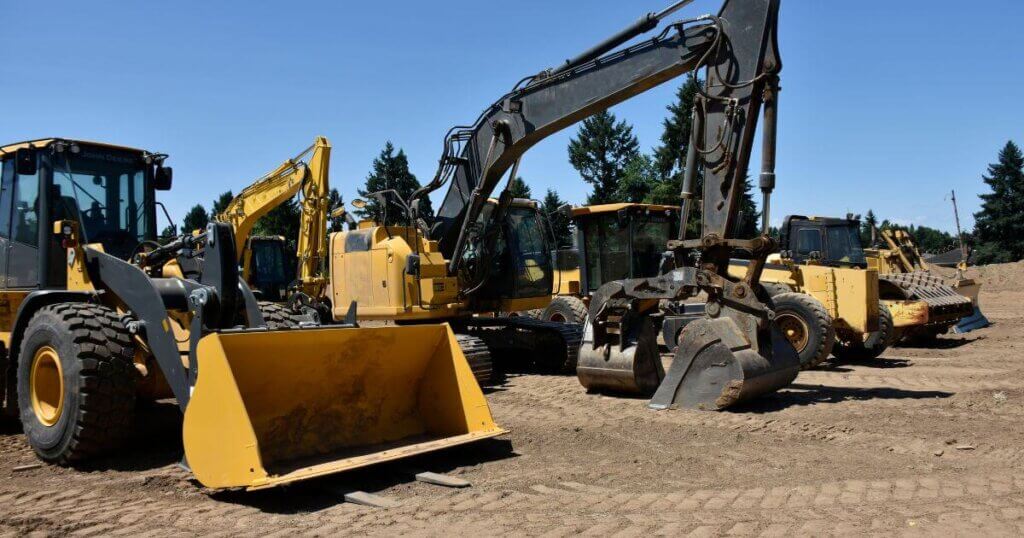Construction projects run on tight schedules, and nothing slows things down faster than missing equipment, misplaced tools, or unexpected delays. Keeping track of everything—especially across multiple job sites—can be a never-ending challenge. That’s where asset trackers come in. Using technology like GPS, sensors, and smart software, construction companies can see precisely where their equipment is, prevent costly losses, and keep projects running smoothly.
Quick look
- GPS, RFID, and IoT sensors help construction firms reduce losses, prevent delays, and streamline operations.
- Asset trackers ensure equipment security, minimize misplaced tools, and improve resource allocation.
- Automated tracking systems schedule preventive maintenance, reducing breakdowns and keeping equipment in top condition.
- Construction businesses should consider scalability, integration, and mobile accessibility when selecting asset tracking solutions.
What are asset trackers?

Keeping track of equipment, tools, and materials on a construction site can be challenging, especially when multiple teams work in different locations. Asset tracking helps construction companies know precisely where their resources are, reducing the risk of lost or stolen equipment and keeping projects running smoothly.
At its core, asset tracking uses technology to monitor and manage physical assets. This can include:
- GPS trackers: GPS tracking uses satellite signals to provide real-time location data, which is ideal for vehicles and heavy machinery.
- RFID (Radio Frequency Identification): This uses small tags scanned by a reader to track tools and materials, great for warehouses and inventory management.
- IoT sensors (Internet of Things): Smart sensors that collect data on location, usage, and equipment conditions.
- Telematics: A combination of GPS, sensors, and software that tracks fleet and equipment performance, fuel usage, and maintenance needs.
Types of assets
Asset trackers aren’t just for large equipment—they help construction companies manage everything from bulldozers to power drills. By knowing where these assets are at all times, companies can reduce downtime, cut replacement costs, and improve overall efficiency on the job site. Commonly tracked assets include:
- Heavy machinery – Excavators, bulldozers, cranes, and loaders.
- Vehicles – Trucks, vans, and company-owned fleet vehicles.
- Power tools – Drills, saws, generators, and welding equipment.
- Materials and inventory – Lumber, steel, concrete, and other essential supplies.
Why asset trackers are essential for construction firms
Construction sites are fast-paced environments where tools, equipment, and materials are constantly used. Without a solid tracking system, things can quickly go missing—whether due to theft, misplacement, or simple mismanagement. Asset trackers help construction firms keep everything accounted for, reducing unnecessary costs and keeping projects on schedule.
Preventing theft and loss
Construction site theft is a massive problem, with stolen equipment costing the industry hundreds of millions annually. According to the National Equipment Register (NER) and the National Insurance Crime Bureau (NICB), heavy equipment theft results in over $1 billion in annual losses in the United States, with less than 25% of stolen equipment being recovered.
Smaller items like power tools are easy targets, but even heavy machinery can be stolen and sold on the black market. Asset tracking technology, such as GPS trackers and RFID tags, helps construction companies monitor equipment locations in real-time and quickly respond to unauthorized movement.
Improving equipment utilization
Not all project delays result from missing equipment. Sometimes, machines sit unused while teams scramble to find the right tools. With asset trackers, companies clearly understand which equipment is used, how often, and where inefficiencies exist. This prevents unnecessary machinery rentals or purchases and ensures that high-demand assets are distributed where needed most.
Reducing downtime and delays
A lost or misplaced piece of equipment can slow a job site down, costing time and money. Asset trackers allow teams to locate what they need instantly, reducing downtime and keeping work on track. Many tracking solutions also include geofencing, which alerts managers when equipment leaves a designated area, helping prevent accidental mix-ups or unauthorized use.
Enhancing maintenance management
Unexpected breakdowns can halt construction projects. Asset tracking systems often include telematics, which monitor engine hours, usage patterns, and maintenance schedules. Instead of waiting for something to break, companies can schedule preventive maintenance, extending the life of their equipment and avoiding costly repairs.
Streamlining compliance and safety
Construction safety regulations require regular inspections and maintenance of equipment. Keeping these records manually can be overwhelming, but asset trackers automate the process by logging maintenance history, tracking certifications, and alerting managers when an inspection is due. This keeps construction firms compliant with safety standards and reduces the risk of accidents caused by faulty equipment.
How asset trackers work
Keeping track of construction equipment, tools, and materials used to mean endless spreadsheets, paperwork, and guesswork. Now, technology makes it easier to know precisely where things are, how they’re being used, and when they need maintenance. Asset trackers rely on a mix of GPS, sensors, and cloud-based software to provide real-time visibility and automate record-keeping. Here’s how it works:
GPS and telematics: Tracking heavy equipment in real-time
GPS and telematics provide real-time location tracking for large assets like bulldozers, excavators, and company vehicles. GPS trackers are installed on machines and transmit location data, making it easy to see where equipment is at any given moment.
Telematics takes asset tracking further by providing detailed insights into equipment performance and usage. Beyond simply tracking location, telematics systems monitor fuel consumption, engine hours, and operational efficiency, helping construction firms optimize resource allocation and reduce unnecessary costs. These systems can also detect potential mechanical issues in real-time, sending automatic alerts when maintenance is due—preventing breakdowns, extending equipment lifespan, and ensuring that machinery stays in peak condition.
RFID and barcode scanning: Keeping tabs on small tools and materials
Not all equipment is large enough for GPS trackers. Smaller assets, such as power tools, hand tools, and materials, are best managed with RFID (Radio Frequency Identification) tags or barcode scanning
- RFID tags: These small electronic tags store data about an asset and can be scanned using a handheld reader. Unlike barcodes, RFID tags don’t require direct line-of-sight scanning, making it easier to check inventory quickly.
- Barcode scanning: A simple and cost-effective way to track tools and materials, barcodes can be scanned using a smartphone or handheld device.
IoT sensors and cloud-based software: Smarter construction management
The Internet of Things (IoT) is changing how construction sites operate. IoT sensors placed on machinery or embedded in trackers collect data on equipment usage, temperature, vibration, etc. This information is automatically sent to cloud-based software, where construction managers can monitor asset performance and make data-driven decisions.
Top companies providing asset trackers for construction
With so many moving parts on a construction site, asset tracking technology helps keep equipment, tools, and materials organized and accounted for. Several companies offer solutions tailored specifically for the construction industry, helping businesses reduce losses, improve efficiency, and streamline operations. Here are some of the top providers for material tracking:
Samsara
Samsara offers robust asset tracking solutions tailored for the construction industry. It provides real-time GPS tracking for both powered and unpowered equipment. The platform helps construction firms prevent theft, optimize equipment utilization, and streamline maintenance with geofence alerts, remote diagnostics, and automated maintenance scheduling features.
In addition to GPS-based tracking, Samsara recently introduced asset tags, compact Bluetooth tracking devices designed for small, high-value items like toolboxes and specialized equipment. These tags make it easier to locate misplaced tools, improving inventory management and reducing downtime on the job site.
With Samsara’s integrated platform, construction companies can monitor their assets from anywhere, ensuring efficiency and security across all job sites.
ZenduIT
ZenduIT specializes in telematics and fleet asset trackers, offering solutions that help construction firms monitor vehicle usage, equipment performance, and maintenance schedules. Their platform integrates with GPS trackers, IoT sensors, and fleet management tools, giving construction managers real-time visibility over their assets. ZenduIT’s tools help optimize operations, reduce fuel costs, and improve overall asset utilization.
Trimble
Trimble provides advanced GPS trackers and telematics solutions that help construction companies manage their fleets and equipment efficiently. Their asset tracking technology allows firms to monitor location, usage, and maintenance needs, reducing downtime and preventing unauthorized use of machinery.
Tenna
Tenna offers a complete asset tracking system for construction companies, covering everything from heavy equipment and fleet vehicles to tools and materials. Their platform combines GPS, RFID, and cloud-based software to track location, maintenance history, and utilization, helping businesses maximize their investments.
Geotab
Geotab provides fleet management and telematics solutions that integrate with asset tracking systems, allowing construction firms to monitor vehicle movement, fuel consumption, and safety compliance. Their technology helps optimize fleet efficiency while reducing operational costs.
Hilti ON!Track
Hilti ON!Track is designed to manage small equipment and tools on construction sites. Using RFID technology, this tracking solution helps contractors track inventory, reduce tool loss, and ensure compliance with safety regulations. The system provides real-time insights into tool availability, helping teams stay organized and productive.
Choosing the right asset trackers for your business
With so many asset tracking options, finding the right one for your construction business can feel overwhelming. The best solution depends on the size of your company, the type of assets you need to track, and how you plan to use the data. A good asset tracker should do more than just tell you where your equipment is—it should help you prevent loss and keep projects running smoothly. Look for features like:
- Real-time trackers: Knowing where your equipment is at any moment reduces downtime and improves productivity.
- Geofencing: Get alerts when equipment moves outside a designated area to prevent unauthorized use or theft.
- Mobile access: Cloud-based systems with mobile apps let workers check inventory, scan equipment, and access reports from anywhere.
- Integrations: Choose a system that works with your existing fleet tracking or project management software to streamline operations.
Scalability and cost
Some asset trackers are better for small contractors managing a handful of tools, while others support large construction firms with hundreds of machines and job sites. Consider:
- Scalability: Will the system grow with your business? Look for solutions that allow you to add more assets, users, and features as your company expands.
- Pricing structure: Some systems charge per asset, while others offer flat-rate pricing. Make sure the cost aligns with your budget and the value it provides.
- Hardware costs: Some tracking solutions require physical GPS devices, RFID tags, or barcode scanners—factor in the cost of any additional equipment.
User experience and training
Even the most advanced asset trackers won’t be helpful if your team struggles to use them. Consider the easy implementation of the system and whether it fits into your existing workflows.
- Ease of use: A simple, intuitive interface reduces the learning curve and improves adoption.
- Training and support: Look for companies that offer onboarding, customer support, and training to help your team get up to speed.
- Automation and reporting: Automated alerts and detailed reports make it easier to stay on top of maintenance, compliance, and asset utilization without manual trackers.
Bottom line
Keeping track of tools, equipment, and materials is one of the biggest challenges in construction. Still, asset trackers make staying organized, preventing losses, and keeping projects on schedule easier. Whether you choose GPS trackers for heavy machinery, RFID tags for tools, or IoT sensors for real-time data, these solutions help construction firms cut costs, improve efficiency, and reduce downtime.
Looking for more insights on the latest construction tech? Subscribe to our newsletter and follow us on social media for industry updates, expert tips, and strategies to optimize your operations.



